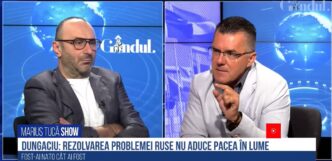
I’ve been walking for an hour on a road that reminds me of how life goes: a sad, tiring piece of time, it seems impossible to go on, you can’t see the end, you want to stop and go back, you get angry, you curse whoever you can, you wonder who made you do this, why didn’t you choose something else, maybe another way, how long until it will be good?
Then, suddenly, it flows smoothly, you put it in gear, you’re happy, you feel like you’re flying, you want the good to never end, in fact you’re really glad you had patience, you start looking left, right, enjoying what you see, you have, you chose, you think it’s the coolest thing you’ve done lately, it doesn’t matter how bad it’s going to be later or how bad it was, it’s good now.
And the asphalt is gone again. It’s the 70-kilometre road linking Tulcea to Chilia Veche, the end of one of the worlds of the Delta and Romania. And the only one. Like life.

It took 2 1/2 hours to get from Tulcea to Chilia Veche. It is the furthest point in the Delta you can drive to. But the road is so bad that you can’t go more than 25 km/hour, maybe 30 km at the maximum, and only 15-20 km/hour if you want to protect your car. The absolute minimum time you can cross the road in is 2 hours. The maximum is stretched depending on what car you have, how much you care about it and how resourceful you are.
- Note for those who have never been to the area: as soon as you get off the ferry crossing the Danube, you enter the village of Tudor Vladimirescu, which also belongs to the municipality of Tulcea. But after leaving the village, you enter the Danube Delta reserve area, where sometimes a border policeman is waiting for you. If you meet him there, he asks for your papers and warns you to buy a car and people permit to enter the reserve. If you don’t find it there, you still need a permit to go ahead and you can buy it online from the ARBDD website.


It is a county road, which belongs to the Tulcea County Council and which has seen asphalt only on the portions that cross the villages because these were rehabilitated by the municipalities.
Former European Funds Minister Eugen Teodorovici (and former PSD senator from Tulcea) proposed to the County Council in May that the road be handed over to the government for rehabilitation.
In 2018, when Tulcea county and especially the Danube Delta were beginning to take in the billion euro from the EU for the modernisation of the region, the CJT’s attempt to attract EU money for the asphalting of the road failed. Authorities claim it was blocked by an agricultural businessman working the land along the road.
In fact, all along the two-to-three hour drive on the left you are accompanied by the great arm of the Danube, and on the right, as far as the eye can see, is farmland, from wheat, corn, yellow curtains of sunflowers, bales of sun-blackened straw, and sheets of land that are incredibly green for the scorching August heat. Ahead, puffins hold your path, and every now and then you’re wooed by a gull of dream-like blue, one of the most beautiful birds I’ve ever seen.




If it were asphalted and you drove it in 40-50 minutes, the Tulcea-Chilia road would be one of the most beautiful in the region, because it has something special, a quietness and a certain kind of light, a harmony that washes away all the pressure of the city you come from, of your job and the pettiness of every day. This quietness is pleasantly deepened once you arrive in the locality. A boat awaits you at the entrance and a village without fuss.



To get to Chilia, you pass through Plauru and Ceatalchioi, two ghost villages put under the spotlight after fragments of the bombs with which the Russians attack Ukraine arrived there. From there, at night, you can see how Ismail is being bombed. Overseas newspapers headlined in a pretty dramatic fashion that these were “the first pieces of NATO” affected by the Russian savage war in Ukraine. A few kilometres further into the delta, Chilia awaits.
It has the village-residence of the same name and also had the villages of Câșlița, Ostrovu Tătaru and Tatanir. Today, the commune of over 53,000 hectares still has a population of 1,700, according to the 2021 census. However, it is the most populated rural settlement in the Danube Delta.
The villages of Câșlița and Ostrovu Tătaru have disappeared from the records, according to the National Institute of Statistics, and Tatanir still has 3 inhabitants. In the deserted villages, however, there are many boarding house roofs and tourists swarming along the arms and canals of the Danube, which is coiling like a diligent snake around the patches of land. The legend, passed down from generation to generation, recalls a Greek colony in the area, fortified by a general of Alexander the Great.
The fields of the villages abandoned by the locals still bear fruit, and are even coveted by the local landowners, who have ended up renting them out, in some cases at derisory prices and with leases many years long.



Only thing is, the single way to reach the crops is by boat. For example, to go to Ostrovu Tataru, an isolated island between Chilia Veche and the Chilia arm, you either come with a boat in your hands, or you are “pulled” by a gentleman with a floating platform. And when I say he will pull you, I mean it literally, because he uses physical force, a cable and the wonders of physics, so he even moves cars on either side of the Tataru Arm.



The people who run this service administered by the town hall live in two old shacks, without light or running water, and in the harsh blizzard, and in the hot summers of the puddle.



Chilia Veche mirrors Chilia Nouă, where Stephen the Great built the Chilia Fortress in 1479 to strengthen the defence of Moldavia against the Ottomans. New Chilia passed through an endless series of administrations, from the Ottoman Empire, to the Russian Empire, to Moldavia, then to Great Romania, then to the USSR, then to Romania for a short time and then to Ukraine until today. It is part of the Odessa region and lies not 30 kilometres from the Ismail bombed the other day by the Russians. It can be bombed at any time and is the twin of Old Chilia.
It’s strange how sitting on the pond in Old Town, the calmness that floats in the air, the stillness and the lack of any worries swim in your brain, like in a heaven for the exhausted. And on the other side lurks Hell in all its forms. More political if you like, it’s strange how NATO space is separated from the most bitter war on the organisation’s border by just 300 metres of water.



In Chilia, the only churches are one of the Russian Lipovans and another of “Ukrainians”, as the Lipovenes claim. The “Ukrainian” church, which dates back to the Ottoman Empire in 1854, actually belongs to the Romanian Orthodox Church and is undergoing major repairs, while the Russian one is frozen in time, although built in 1910. Both are must-visits if you pass through Chilia.


Chilia, with its villages forgotten among the reeds and the puddles still has about 1700 souls living in it. The people you meet in the lanes will tell you that there are no more locals in the other three villages, and the only people who pass through are tourists, looking for lipovenese fish borscht or whatever else you may be able to throw into a pot. And there are more and more of them. In 2021 alone, 10 new guesthouses were built in Chilia Veche.
Towards the evening, the atmosphere in the Chilia port is as lively as when listening to the song of the same name. The song is reminiscent of the political prisoners who were tortured in prisons at the end of the world, in the marshes, like the one in Chilia or the one in Periprava.
Now, at the port of Chilia, it’s just kids riding their bikes along the newly renovated cliff, along which the town hall has set up a “boat park”. Two ladies are setting bait on hooks and exchanging impressions of politicians and the food they have recently put on the table.




Ne bucurăm că ne citești!
Dacă vrei să ne și susții:











